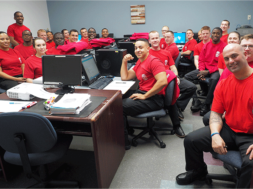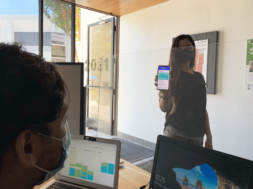
Applying the Principles of Change Management to Campus Operations
By Barbara Larar, Chief Operating Officer and John Olson, Ed.D., Campus President, ECPI University
“Change is the only constant.” – Heraclitus, Greek Philosopher, c. 475 BCE
Try a little experiment. Cross your arms and wait 15 seconds. Now cross them again the other way. How did that minor change make you feel? In one pose, your left hand is on top of your right arm, and then in the next it’s underneath. Small variation, but it felt different. Something that small, that minor, can make you feel “uncomfortable” or “different.”
Today’s constant is that by tomorrow everything will have changed. Technology has been a great equalizer, but it has also been a great disrupter.
Those disruptions place stress upon many who are impacted by the change or modification from one state to the next. The economy has shifted from such disrupters as Walmart, Amazon, Microsoft, Apple. Relationships have been started or rekindled with Facebook, Snapchat, Twitter. Job searching and headhunting have become searches on LinkedIn, Indeed, Monster. Systems and businesses that were once stable have either evolved or disappeared. Employees (faculty and staff) are constantly bombarded with new systems, new policies, new regulations – all making for discomfort, uneasiness, anxiety.
Imagine you are given a project to complete. You evaluate the project, break it down into milestones, determine who and what is needed, and begin. You and your team start, and you see progress. Suddenly, just when you feel you are making some progress, a couple of team members are shifted to another project; costs need to be cut, so your budget is slashed; policies change without communication and justification; but the expectation, the original outcomes are the same. What to do?
John Kotter with the Harvard Business School published “Leading Change: Why Transformation Efforts Fail” in the Harvard Business Review (1995) and then a book entitled “Leading Change” (2012). The article describes eight errors that derail transformation, and then the book flips the focus to explore the eight-stage process for creating lasting change. To help combat this anxiety and control change, career college leaders at all levels can use the basic principles of change management to guide them through these transformative and evolving times. Change must and will happen, but what’s important is how leadership teams manage the whole process to guide their faculty and staff through the change.
First, the leadership needs to establish a sense of urgency (Kotter, 2012). Many initiatives fail from the get-go because of an overall sense of complacency. “This is how we do it,” faculty and staff think. And they have seen past change events take place, but within a short time, things are back where they were – “the more things change, the more they stay the same,” employees begin to think. Therefore, leaders need to foster that sense of urgency by looking at the data, conducting market research, and communicating with the employees. To do this, leaders can let the employees know that a crisis (drop in enrollments or lost jobs) may be pending if the current path is not altered. Goals can be set high enough so that they look unreasonable using the current system. Or dissatisfied students or employers can provide feedback as to their experiences with the school. Complacency will want to maintain a status quo, but as faculty and staff begin to see that the current way is not producing the desired results, they will be more willing to look at new approaches.
Once a sense of urgency is established, the second step is to have a champion (Kotter, 2012). But not one person.
There needs to be a team capable of building a coalition that can make things happen.
Members should be from across the departments (academics, career services, financial aid, admissions), and representation of senior management and leadership should be present. This coalition should have positional and personal power (and charisma) and be seen as highly credible by the other members of the campus.
In the third step, to combat the complacency, the faculty and staff need to have a vision statement of what the future would look like. Kotter wrote that “a vision says something that clarifies the direction in which an organization needs to move” (1995). The vision creates an attractive picture of how things will be in the future. It allows the faculty and staff to differentiate between how things are today versus what they will be like in the future when the vision is realized. To start the process, one or two key people may craft the first few drafts, which may be vague and foggy, but as more people become involved in the process, clarity can be added to the statement. Underlying the vision are the broad strategies for realizing the vision.
With all the technology available today, the fourth step of the process should be the easiest – communication. The coalition needs to communicate the change vision. However, in the age of information, communication does not always occur. Kotter (2012) outlines the key elements to effective communication – keep it simple, paint a picture, use multiple communication channels, repeat and then repeat again, set the example, and accept feedback.
Empower means giving people (faculty and staff) the authority to act. Leadership and management have set the vision and developed strategies, but if nothing else changes, if systems and structures are not compatible with the change, little will happen (Kotter, 20102). Faculty and staff need to believe that the actions they are taking are contributing to the new vision. Results will not differ if the process remains the same. In the fifth stage, after vision and the system are aligned, leadership needs to ensure that the faculty and staff have the appropriate level of training. Knowing what to do but not how to do something will lead to failure and frustration. In addition, mid-level managers need to buy into the vision and strategies. If program directors, lead faculty, directors of admissions and career services have not accepted the new vision, they will thwart and foil the efforts of their direct reports.
The vision and strategy set the course, the faculty and staff can get excited and motivated by where they think the organization is going, but this anticipation and the charisma of the leader can only go so far. In the sixth stage, now leadership needs to create short-term wins to show how to attain the overall vision (Kotter, 2012). By breaking the larger strategy into smaller and manageable wins, faculty and staff see progress being made toward the vision.
The wins help maintain and build the confidence of the change adopters; more importantly, the short-term wins thwart the negativity of the nay-sayers.
The seventh stage of the change management process is the flywheel effect (Collins, 2001). To change is a continuous process that starts slowly, but as more small wins are realized, the momentum of the flywheel picks up. Smaller wins add up, so the coalition is now able to tackle bigger and more sweeping changes (Kotter, 2012). Their credibility grows and buy-in from more people join into the movement. Now even senior management focus on the vision and strategies.
The final stage is the most difficult and most transformative. To make change stick, there needs to be a cultural shift (Kotter, 2012). New norms and shared values will only develop after the faculty and staff see the new ways are far better than the old ways. People need to see how the changes have made their performance improve.
These are times of disruption inside and outside higher education. In turbulent times, faculty and staff look for leadership to provide guidance. Change, planned or unplanned, can be very disruptive to operations, but leadership can manage the situation by clearly communicating about the upcoming changes. People want to know the value, so it’s important that the advantages and benefits are clearly delineated. Justification needs to be more than “because I told you so.” The questions “what needs to be accomplished?” and “How will it be accomplished?” require transparency so faculty and staff will have the buy in to make it happen. Management by seeing change as a process can help ensure it happens and sticks.
Works Cited
Collins, J. (2001). Good to great. New York: HarperCollins Publishing Inc.
Kotter, J. P. (2012), Leading change. Boston: Harvard Business Review Press.
Kotter, J. P. (1995, May-June). Leading change: Why transformation efforts fail. Retrieved from https://hbr.org/1995/05/leading-change-why-transformation-efforts-fail-2
BARBARA LARAR is the Chief Operating Officer for ECPI University. She has over 26 years of experience in higher education in general, encompassing academics, admissions and marketing, accreditation, financial aid, and career services. Her interests and past involvement cover all aspects of overall operations and, in particular, the development and implementation of clinical, ancillary and allied health care programs. She was the leader and visionary of the establishment of ECPI University’s College Nursing and Health Science. She has led several initiatives pertaining to programmatic accreditation that resulted in achieving maximum timeframe accreditation allowable. They included: Accrediting Bureau of Health Education Schools (ABHES), Commission on Accreditation in Physical Therapy Education (CAPTE), Joint Review Committee on Education in Radiologic Technology (JRCERT), Accreditation Commission for Education in Nursing (ACEN), Commission on Collegiate Nursing Education (CCNE), Commission on Accreditation for Health Informatics and Information Management Education (CAHIIM) and Commission on Accreditation of Allied Health Education Programs (CAAHEP).
Contact Information: Barbara Larar // Chief Operating Officer // ECPI University // blarar@ecpi.edu
JOHN OLSON, ED.D., is the Campus President for ECPI University’s Newport News campus. He has over 30 years of experience in higher education (28 years with ECPI University) as both a faculty member and a campus administrator. John serves on a variety of boards and currently chairs the Greater Peninsula Workforce Board.
Contact Information: John Olson, Ed.D. // Campus President // ECPI University // jolson@ecpi.edu










